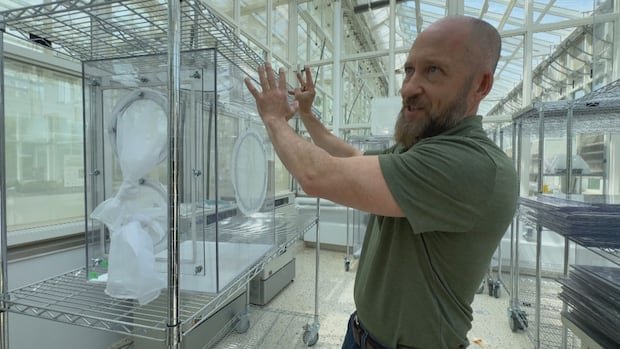In the upper reaches of some of Nova Scotia’s largest trees, a tiny black dot, no larger than a sugar crystal, is causing significant damage. The hemlock woolly adelgid, an invasive insect discovered in the province in 2017, is swiftly spreading through Nova Scotia’s hemlock forests, resulting in eerie, ghost-like trees. By feeding on the sap at the base of hemlock needles, the adelgid can fatally harm a tree in under ten years, leaving behind a white wool-like residue that gives them their name.
At Acadia University, scientists are actively researching methods to combat this issue. Led by Acadia, a research project is evaluating the impact of insecticidal treatments used to manage the hemlock woolly adelgid infestation. Additionally, they are establishing a biological control facility to regulate adelgid populations.
Kirk Hillier, a biology professor at the university and the project’s lead researcher, emphasized the urgency of the situation, having witnessed the devastation caused by the adelgid firsthand. The research project is focused on assessing the effects of adelgid infestation on biodiversity and the outcomes of employing insecticides to treat hemlocks.
The use of insecticides on hemlocks is essential to their survival, as untreated trees are at risk of perishing. Despite potential impacts on pollinators in other contexts, in Nova Scotia, the necessity of protecting hemlocks outweighs these concerns.
To enhance detection methods and guide treatment efforts, the project is experimenting with traps designed to identify adelgid infestations at early stages using molecular tools. This proactive approach aims to slow down the spread of the adelgid by detecting its presence before infestations become severe.
In the long term, researchers plan to utilize the biocontrol facility to introduce natural predators of the hemlock woolly adelgid, such as Laricobius nigrinus beetles and silver flies, to manage the pest population without relying on insecticides. The facility will serve as a hub for rearing and releasing these predators to safeguard hemlocks.
Donna Crossland, a forest ecologist involved in hemlock protection efforts, emphasized the importance of considering both short-term and long-term strategies to combat the adelgid infestation. While insecticides are currently necessary, establishing a biocontrol program is crucial for sustainable hemlock preservation.
Government support is essential in securing funding for the biocontrol program to ensure the long-term viability of hemlocks in Nova Scotia. Hillier stressed the need for public awareness and financial backing to expedite the implementation of biocontrol measures before irreversible damage occurs to the province’s hemlock trees.

